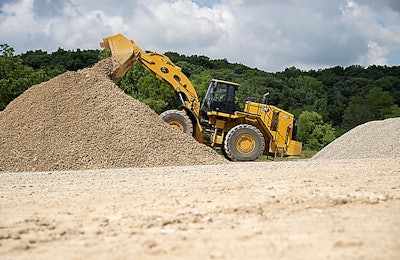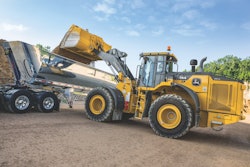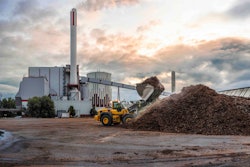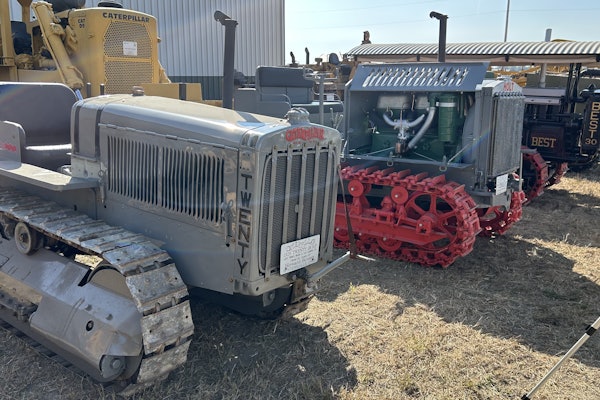
Midsize and large wheel loaders still excel at loading tasks, but new models and features offer versatility to make life easier and more productive for operators.
Some manufacturers are offering a range of models – from basic to high-tech – giving contractors more choices and options to meet different budgets. Loaders are also getting more technology, including object detection for safety, load-sensing to achieve top production – even a transparent bucket to remove operator blind spots.
Operator comfort seems to be at the forefront of OEMs’ designs, as cabs can come decked out with all kinds of features to make the workday a little easier.
In this report, we rundown what’s new for 2024 in midsize and large wheel loaders from Case, Cat, Develon, Hitachi, Hyundai, JCB, John Deere, Komatsu, Mecalac and Volvo.
Case 651G
 The 172-gross-horsepower 651G is the newest large loader from Case. Operating weight is 30,890 pounds. Full lift reach is 2 feet 9 inches and dump height is 9 feet 8 inches, and loader geometry is Z-bar. The standard bucket has 2.75 cubic yards heaped capacity and a curved profile for better material retention. Tipping load is 26,733 pounds straight and 23,167 pounds full turn.Case CE
The 172-gross-horsepower 651G is the newest large loader from Case. Operating weight is 30,890 pounds. Full lift reach is 2 feet 9 inches and dump height is 9 feet 8 inches, and loader geometry is Z-bar. The standard bucket has 2.75 cubic yards heaped capacity and a curved profile for better material retention. Tipping load is 26,733 pounds straight and 23,167 pounds full turn.Case CE
“The new model also features a larger hydraulic pump for increased cycle times, a curved bucket for better material retention and a higher hinge pin for better dumping clearance,” says Neil Detra, product manager.
The 651G also has an 8-inch touchscreen display and adjustable, intuitive electrohydraulic controls for enhanced precision. Boom and bucket responsiveness can be set independently.
Optional payload tracking uses an integrated onboard scale. Axle options include open, limited slip and locking for a variety of conditions.
Cat Goes "GC"
The new 988 GC from Caterpillar exemplifies the GC concept: the performance and reliability of more fully featured models but at a lower cost.
It runs on Cat’s C15 engine, which meets Tier 4 Final and EU Stage V emissions standards. The cooling package offers higher heat rejection with an on-demand fan strategy and two available fan speed settings for standard and high-ambient temperature configuration. Drive is through a Cat Advanced Power Electronic Control Strategy (APECS) transmission with lock-up torque converter.
Load-sensing hydraulics proportion hydraulics between steering and attachment. Optional ride control uses an accumulator for a smoother ride.
Steering and Integrated Control (STIC) steering and Cat Comfort Series III seating with seat-mounted implement pod provide enhanced operator comfort and improved control, the company says.
Options include air-cooled and heated seating, Cat Detect technology for enhanced situational awareness and Cat Payload for on-the-go weighing. Bucket payload is aligned with 988 and 988 XE models with a range of Cat performance series buckets of 8.3 to 10 cubic yards.
Develon Transparent Bucket Now Standard
 The DL320-7 from Develon has a Develon DL08 engine rated at 271 net horsepower and four forward speeds (five speeds with the US15 package only) and limited slip front and rear differentials. Static tipping loads are 34,496 pounds straight and 30,461 pounds at full turn. Options include high-lift and a larger counterweight.Develon
The DL320-7 from Develon has a Develon DL08 engine rated at 271 net horsepower and four forward speeds (five speeds with the US15 package only) and limited slip front and rear differentials. Static tipping loads are 34,496 pounds straight and 30,461 pounds at full turn. Options include high-lift and a larger counterweight.Develon
Transparent Bucket, an industry-first technology, gives operators a virtual "see through" view in front of the loader bucket via a video display on a dedicated monitor. The operator then has no blind spots in front of him when the bucket is raised.
The monitor and the standard 8-inch touchscreen monitor mount on Rhino Rails and can be independently adjusted to suit operator preference. AVM (around-view monitor) provides a 270-degree view and includes object proximity warning.
Develon’s next-generation moving-object detection front and rear provides red and yellow alert triangles to show the relative nearness of moving objects. Cabs from the DL200-7 to the DL580-7 share the same layout and design to ensure familiarity when operators move from one machine to another.
Pressing an ”i” button on the monitor causes all buttons to flash; pressing one displays the function and a brief description of that function. That monitor also allows the operator or service technician to select a function and then see circuit status, voltage, pressure, temperature and other operational and diagnostic information. Fault codes are displayed numerically with a short description.
Engines have Economy, Standard and Power modes. Models from the DL320-7 and up also have situational awareness technology, or SAT, mode. This mode monitors engine and transmission performance and matches engine output to the load, the company says.
Transmission modes are “A” for full automatic; “A2” for automatic operation in gears 2 through 4 for less-demanding applications; and “Manual 1-2-3-4,” which allows the operator to select and hold a gear using a twist shifter on a column-mounted stalk.
Hitachi ZW310-7
 Hitachi’s ZW220-6 has 200 gross horsepower, 4.2 cubic yards standard bucket capacity and a 38,912-pound operating weight. The full powershift transmission has five forward and three reverse gears. Tipping loads are 17,405 pounds at straight and 15,418 pounds at full turn. Options include guards, E-Stick steering, a wide-fin cooling system core and high-lift arm.Hitachi
Hitachi’s ZW220-6 has 200 gross horsepower, 4.2 cubic yards standard bucket capacity and a 38,912-pound operating weight. The full powershift transmission has five forward and three reverse gears. Tipping loads are 17,405 pounds at straight and 15,418 pounds at full turn. Options include guards, E-Stick steering, a wide-fin cooling system core and high-lift arm.Hitachi
“Moving to the new series involves refinement in many areas,” says Chris Trampush, wheel loader product manager. “There is no need for extensive reconfiguring of the very competent -6 Series machines on which these new models are based.”
Visibility is enhanced by a parallel lift linkage, lowering the dash and using a sloped rear hood. The right console and pillar have buttons placed for easier access, and the multifunction joystick is also on the right. The air-ride seating has adjustable armrests. Control options include foot pedals, single and dual joysticks and joystick steering.
The 8-inch color LCD monitor has intuitive menu navigation controls. Payload checker is standard on -7 Series machines.
Rear-obstacle detection and warning gives an audible alert of objects behind the machine. The alert’s sensing distance can be set by the operator. A rearview camera is standard, and Aerial View with 270 degrees of visibility is an option.
Hyundai HL900A Series
 The Hyundai HL985A features a 420-net-horsepower Cummins X12 engine, 9.20-cubic-yard standard bucket capacity and 77,935-pound operating weight. Available configurations are Z-bar, Tool Master and extended boom. Options include a hydraulic locking front axle paired with a conventional rear axle, joystick steering and radar.HD Hyundai
The Hyundai HL985A features a 420-net-horsepower Cummins X12 engine, 9.20-cubic-yard standard bucket capacity and 77,935-pound operating weight. Available configurations are Z-bar, Tool Master and extended boom. Options include a hydraulic locking front axle paired with a conventional rear axle, joystick steering and radar.HD Hyundai
All models except the newest and largest one, the HL985A, can be ordered as XT extended-reach versions.
Three models are available. TM indicate Tool Masters. TM machines have parallel lift for increased lift capacity and greater load stability.
For extra-rugged jobs, models HL955A through HL975A can be ordered as HD heavy-duty. Three models can be ordered with a forestry package.
Standard features on HL900A loaders include an on-board weighing system accurate to within 3%, five years of HiMATE telematics and premium ZF axles with limited-slip rear differentials.
“The many configurations of Hyundai HL900A loaders allow customers to choose the exact right machine for their business,” says David Spooner, product manager.
JCB: 12 Models to Choose From
 The 427 from JCB has 179 maximum horsepower, a 31,656-pound operating weight and full-turn tipping load of 18,966 pounds The most popular configuration includes the JCB CommandPlus cab with seat-mounted controls and HVAC, full autolocking front and rear differentials with torque proportioning rear, JCB Smoothride System and programmable auto-reversing fan.JCB
The 427 from JCB has 179 maximum horsepower, a 31,656-pound operating weight and full-turn tipping load of 18,966 pounds The most popular configuration includes the JCB CommandPlus cab with seat-mounted controls and HVAC, full autolocking front and rear differentials with torque proportioning rear, JCB Smoothride System and programmable auto-reversing fan.JCB
Filters are common across the range. JCB uses industry standard components, such as Rexroth hydraulics and ZF axles, according to JCB heavy line product manager Javier Martin and product specialist Ross Lovette.
All models feature the JCB CommandPlus cab with air-suspension seating, set-and-forget telescopic steering column that tilts up toward the dash for easier entrance and exit and electrically heated and adjustable mirrors. The cab is a four-pillar design, versus the more common six pillar, for improved visibility and uses glass to floor wherever possible, including the door.
In addition to an F-N-R selector stalk on the column, there’s a selector on the joystick, so operators can make directional changes without taking their hands off the joystick. Two 7-inch monitors are standard; one shows operating information and the other has a “?” button to explain and select functions.
LiveLink telematics is standard for five years. The system is designed to work seamlessly with third-party providers of apps that integrate telematics from mixed fleets.
To meet the growing demand for attachments, JCB offers both three- and four-spool hydraulics. In addition to more common attachments such as brooms and snowblowers, specialty tools are flourishing. Examples include those for dismantling scrap vehicles and separating the waste and manipulators for managing large tires, such as those found on construction equipment. Many of these tasks can be performed by excavators, but wheel loaders are better at distributing the output.
Seven of the 12 JCB models are designated Agri. These are targeted at agricultural customers, but construction customers may also find value in their configuration. Features include a six-speed transmission instead of the non-Agri five-speed, more operator comfort, the availability of ag tires, H-bar lift for greater precision and control than the Z-bar, and the availability of both high-lift and super-high-lift capacities.
John Deere’s Three Tiers
 The 744 X-Tier loader is the latest in the line of E-Drive midsize and large loaders from Deere. An electric variable transmission is at the heart of the E-Drive system. The 744 X-Tier will be available in 2024; an 824 X-Tier is expected to launch at the same time. These will join the 644 X-Tier and 944 X-Tier.John Deere
The 744 X-Tier loader is the latest in the line of E-Drive midsize and large loaders from Deere. An electric variable transmission is at the heart of the E-Drive system. The 744 X-Tier will be available in 2024; an 824 X-Tier is expected to launch at the same time. These will join the 644 X-Tier and 944 X-Tier.John Deere
G-Tier machines have pilot controls and cabs with fewer features. P- and X-Tiers have electrohydraulic controls with scalable responsiveness and multifunction buttons, and cabs with heated and ventilated seating and automatic temperature control. A rearview camera is standard; customers can upgrade to enhanced mirrors. The optional Advanced Vision System provides a 270-degree view, and rear-object detection is rolling out as a running change during production.
The 444 through 944 P- and X-Tier models have fully functioning SmartWeigh as a low-cost option for a 250-hour trial, available as a factory option or field install kit. There is also a backward-compatible field install kit to add SmartWeigh to 744 L to 904 L Series loaders.
In P- and X-Tier levels, steering options include steering wheel, joystick steering or both, depending on the model.
SmartDetect was recently launched as a field kit for P- and X-Tier utility and production class loaders, except the 944 X-Tier. SmartDetect provides an audible alarm when the system detects a person or object behind the machine.
John Deere Operations Center will assist with alerts and PM management as well as Deere Rebuild and ReLife programs to extend loader service life as a primary or secondary machine. “Customers are encouraged to work with their dealers, many of whom are certified rebuild centers,” says Matt Costello, product marketing manager.
All midsize and large P- and X-Tier loaders are hybrid design with diesel engines and electrified drivetrains. Each comes with a five-year electrical assurance plan. The hybrid design provides more power with less fuel than traditional diesel-only machines, the company says.
Komatsu WA475-10
 The Komatsu WA475-10 has a Komatsu engine rated at 291 gross horsepower with Power and Economy modes, an operating weight of up to 60,400 pounds and standard bucket capacities of 5.5 to 6.0 cubic yards. The Advanced Joystick Steering System is an available option to replace the standard steering wheel. Boom positions are adjustable from the cab, and three positions can be set for recall to make attachment changes easier because there’s no need to reset the bucket position.Komatsu
The Komatsu WA475-10 has a Komatsu engine rated at 291 gross horsepower with Power and Economy modes, an operating weight of up to 60,400 pounds and standard bucket capacities of 5.5 to 6.0 cubic yards. The Advanced Joystick Steering System is an available option to replace the standard steering wheel. Boom positions are adjustable from the cab, and three positions can be set for recall to make attachment changes easier because there’s no need to reset the bucket position.Komatsu
“That’s fine as long as production requirements don’t change. But if more trucks show up on a given day, that smaller loader will not be sufficient, and that’s a problem that cannot be fixed overnight.”
A better option is to invest in a loader with a margin of capacity, such as the WA475-10 with its range of bucket capacities to match customer needs, he says.
The WA475-10 features independent work equipment control that provides two distinct power paths through a mechanical planetary transmission and hydrostatic transmission. This separates the speed of the work equipment, which is controlled only with levers, from the accelerator pedal while preserving the convenience and performance of hydrostatic drive. Operators can approach trucks with full bucket power without brake dragging, reducing lifetime owning and operating costs, according to Komatsu.
Cab features include two fewer pillars for improved rear visibility, a rear monitoring system and adjustable air-suspension seating.
Mecalac AS1600 Swing Loader
 The AS 1600 swing loader from Mecalac has a Deutz engine rated at 136 horsepower, an operating weight of 24,074 pounds and bucket volumes of 2.1 to 3.3 cubic yards. Electronically controlled traction drive and engine performance are interconnected to reduce fuel consumption.Mecalac
The AS 1600 swing loader from Mecalac has a Deutz engine rated at 136 horsepower, an operating weight of 24,074 pounds and bucket volumes of 2.1 to 3.3 cubic yards. Electronically controlled traction drive and engine performance are interconnected to reduce fuel consumption.Mecalac
The non-articulating frame preserves lift capacity throughout the swing range, the company says. Rated operating capacity is 13,228 pounds straight and 13,250 pounds over the side. The tire contact patch does not move as the loader swings, for further stability, the company says.
Attachment points for the lift arms and cylinders are behind the vertical steering axis for mechanical advantage, according to Mecalac.
Rear axle lockouts engage at 17 degrees of turning to limit vertical compliance, and the lift cylinder communicates with the rear axle to engage the axle-lockout cylinder during lift cycles. Dual load-sensing hydraulics deliver flow sharing between the drive and work circuits.
Both a crane attachment and forks are offered by Mecalac. Mounting is via an ISO 23727 coupler, which is compatible with a wide range of attachments.
The ability to work over the side is especially helpful for material spreading, backfilling trenches, grading, snow removal and placing pipe. It also cuts loading cycle times by eliminating the need for V- or Y-pattern loading. You simply load the bucket, back to the truck, swing the loader over the side and dump.
“Mecalac swing loaders provide efficiency and value that are unique to their design and serve the interests of a wide range of customers,” says Peter Bigwood, general manager, Mecalac North America.
Volvo’s New Offerings
 The L180H from Volvo has a Volvo D13J engine rated at 330 gross horsepower, an operating weight of up to 62,610 pounds, bucket capacities of up to 20.9 cubic yards and a static tipping load at full turn of 41,580 pounds, according to the Volve CE website. Improved performance of the new generation OptiShift provides greater fuel savings over its G-Series predecessor.Volvo Construction Equipment
The L180H from Volvo has a Volvo D13J engine rated at 330 gross horsepower, an operating weight of up to 62,610 pounds, bucket capacities of up to 20.9 cubic yards and a static tipping load at full turn of 41,580 pounds, according to the Volve CE website. Improved performance of the new generation OptiShift provides greater fuel savings over its G-Series predecessor.Volvo Construction Equipment
Service intervals are extended to 1,000 hours.
The ignition key activates and powers the machine; no need for a separate main switch and no risk of battery drain if that main switch is not turned off overnight, the product manager say.
Volvo Co-Pilot tablets with on-board weighing come standard, along with high-definition cameras, radar-detect and collision-mitigation systems.
Also new is the L180 Three-Pass Rehandler, based on the popular L180H wheel loader. Features of the Rehandler include larger tires for improved lateral traction, flotation, durability and cut resistance. A long boom and rehandling counterweight deliver an extra 675 pound-force of breakout force, 2 feet of additional dump clearance and approximately 0.25 cubic yards of additional bucket capacity. The additional reach reduces wheelspin by allowing the operator to keep the loader farther back and away from loose material when filling and dumping while still dumping to the center of the dump body, the company says.
Four bucket options are available, from 6.3 to 7.6 cubic yards. Comfort Drive Control provides steering via a small lever.
All three models feature Volvo Reverse By Braking. Control options include single and multiple joysticks. Three hydraulic response modes are also standard.














